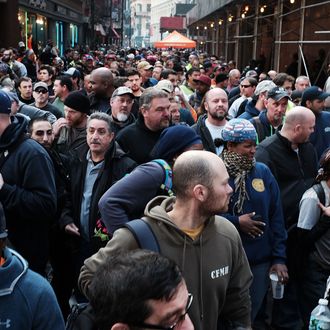
From the point of view of the attention being paid to it in analysis of both parties’ presidential contests and the general election as well, you could possibly call 2016 the Year of the White Working Class. Self-styled populists of the left and the right are arguing that Democratic and Republican party elites are reaping the whirlwind from years of sacrificing white-working-class interests to upper-class economic and cultural preoccupations, as evidenced by the strength of Donald Trump and Bernie Sanders.
There are good reasons for this preoccupation. Among Democrats there is a sort of moral obligation to ask why a category of voters once fundamental to the New Deal coalition has strayed so far. And the conflicting interests of the white-working-class and big-business branches of the GOP have been evident for a good while and have this year finally blown up into a shocking presidential nomination and a potentially deep party split.
But it’s important to remember, as Jamelle Bouie reminds us at Slate this week, that while the white working class is interesting, the working class as a whole is a lot less white than it used to be. And ignoring the views and interests of the black and brown elements of the working class is as big a mistake empirically and morally as ignoring non-college-educated voters generally. Marshaling data from the Economic Policy Institute, Bouie notes the trends that are steadily eroding the stereotypes of “blue-collage” wage earners as white folks:
As recently as 2013, more than 60 percent of working-class Americans between 25 and 54 years old were white. If you extend the age bracket to 64, that increases to nearly 63 percent. But in 2014, those numbers—for the first category—dropped to 59.6 percent. In 2015, it was 58.8 percent. This year, non-Hispanic whites are 58 percent of the working class, a historic low.
The idea of the “working class” being composed of the horny-handed sons of toil is a bit archaic as well:
[C]lose to half of all working-class people—across all races and ethnic groups—are women working in service jobs as well as traditional blue-collar professions.
So loose talk about Trump cutting deeply into the working-class vote misses much of the picture:
The truth is that it’s inaccurate to talk about Trump’s “working-class appeal.” What Trump has, instead, is a message tailored to a conservative portion of white workers. These voters aren’t the struggling whites of Appalachia or the old Rust Belt, in part because those workers don’t vote, and there’s no evidence Trump has turned them out. Instead, Trump is winning those whites with middle-class incomes. Given his strength in unionized areas like the Northeast, some are blue collar and culturally working class. But many others are not. Many others are what we would simply call Republicans.
I’d add that a myopic approach to the working class that limits it to white people sometimes infects analysis of Democratic primaries as well. Bernie Sanders gets a lot of props for his appeal to the white working class, and is sometimes viewed as Donald Trump’s primary competitor in this demographic. While Sanders has (by my back-of-the-envelope calculation) carried non-college-educated white voters in 14 of the 24 primaries and caucuses with exit polls (Hillary Clinton won them in six states, and they were basically tied in the other four), he’s lost non-white non-college-educated voters just about everywhere. That shouldn’t be a footnote. Nor should the frequent comments on the political left about Clinton betraying “the working class” and now suffering the electoral consequences go unchallenged without some attention being paid to her robust support among working folks who happened to be non-white or non-male.






























